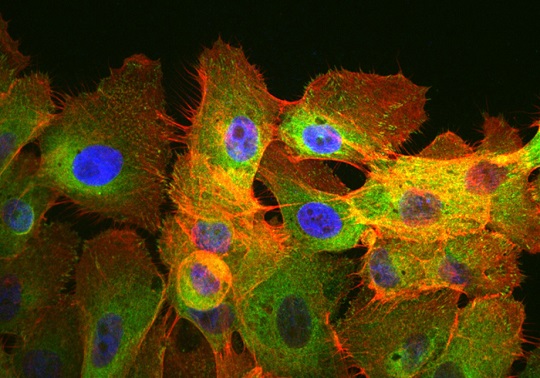
This new study published in the Science Magazine provides new research ideas and possibilities on wound cicatrization.
The Science Magazine has recently published a study carried out by researchers from the IBEC (Catalonian Institute of Bioengineering in which they observe how different types of cells feel attracted to the tissue’s most rigid parts. This phenomenon has been named collective durotaxis
It reinforces the idea of Collective Intelligence, a very stylish aspect which is turning into great developments within the scientific world. A group of cells can tackle the job a single one cannot: group behaviour is different to isolated behaviour. “The key is not any of the individual’s properties, but its interaction with his fellow ones”, ensured Xavier Trepat, head of the study.
This study by IBEC breaks with the traditional belief that cells move due to variations in the chemical concentration of proteins and ions. As this video shows, a group of breast epithelium cells can expand asymmetrically along a surface with an increasing rigidity. The coloured lines mark their trajectory and the green points signal the nucleus. We can clearly see how cells move faster towards the rigid part of the surface.
Collective durotaxis opens new research lines on wound cicatrisation and metastasis as all we new before may now change. Once the cells’ mechanical trajectory is completely known, it could be possible to accelerate the cicatrisation process.
The importance of what cells do at a group level is vital. In the experiments developed to contrast the study have proved that, the bigger the group, the more efficient their movement and that individual cells are unable of finding their path to the most rigid parts.
“Tumours are more rigid than their environment, so collective durotaxis can explain the mechanisms used by tumour cells to move in order to start the metastasis process”, pointed out Trepat. The leader of the research ensures that “wounds are also more rigid than their environment”, hence, they believe that, with this study, collective durotaxis “is a key mechanism to explain how cells move in order to cicatrise wounds and how can we control such process”.
The research has also counted with the participation of scientists from the University of Barcelona (UB), the Universitat Politècnica de Catalunya BarcelonaTech (UPC), the University of Zaragoza, the Centre of Biomedical Research Centre in CIBERES (Network for Breathing Diseases) and the Biomedical Research Centre in CIBER-BBN (Bioengineering, Biomaterial and Nanomedicine Network).








